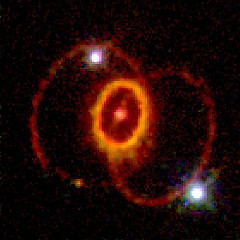

|
The International Conference
|
Abstract A technique for detecting harmonics in sparse quantum flows is developed when it is impossible to describe a light curve. A problem that is insoluble in the time representation can be exactly solvable in the Fourier frequency representation. To demonstrate the capabilities of ultra-high-frequency photometry, we present a numerical experiment. We show that at a sampling time of one microsecond on the 2 m telescope, harmonics can be detected in the frequency range up to 500 kHz for an object with U = 14.5. We demonstrate the application of the described technique to the analysis of gamma-ray flare from the Compton Gamma Observatory CGRO. In the BATSE trigger No. 207 in an energy channel of 25-50 keV with flare duration of 0.030 ± 0.002 s, two significant harmonics at 190 and 310 kHz with half-widths of about 25 kHz are fixed, which correspond to velocities of 25,000 km / sec (∼ 0.08 speed of light). The size of the object is estimated to be ∼ 6000 km, and the size of the active region is ∼ 484 km. A possible scenario for gamma ray flare is the merging of a black hole of stellar mass and a neutron star.
Reference:
|